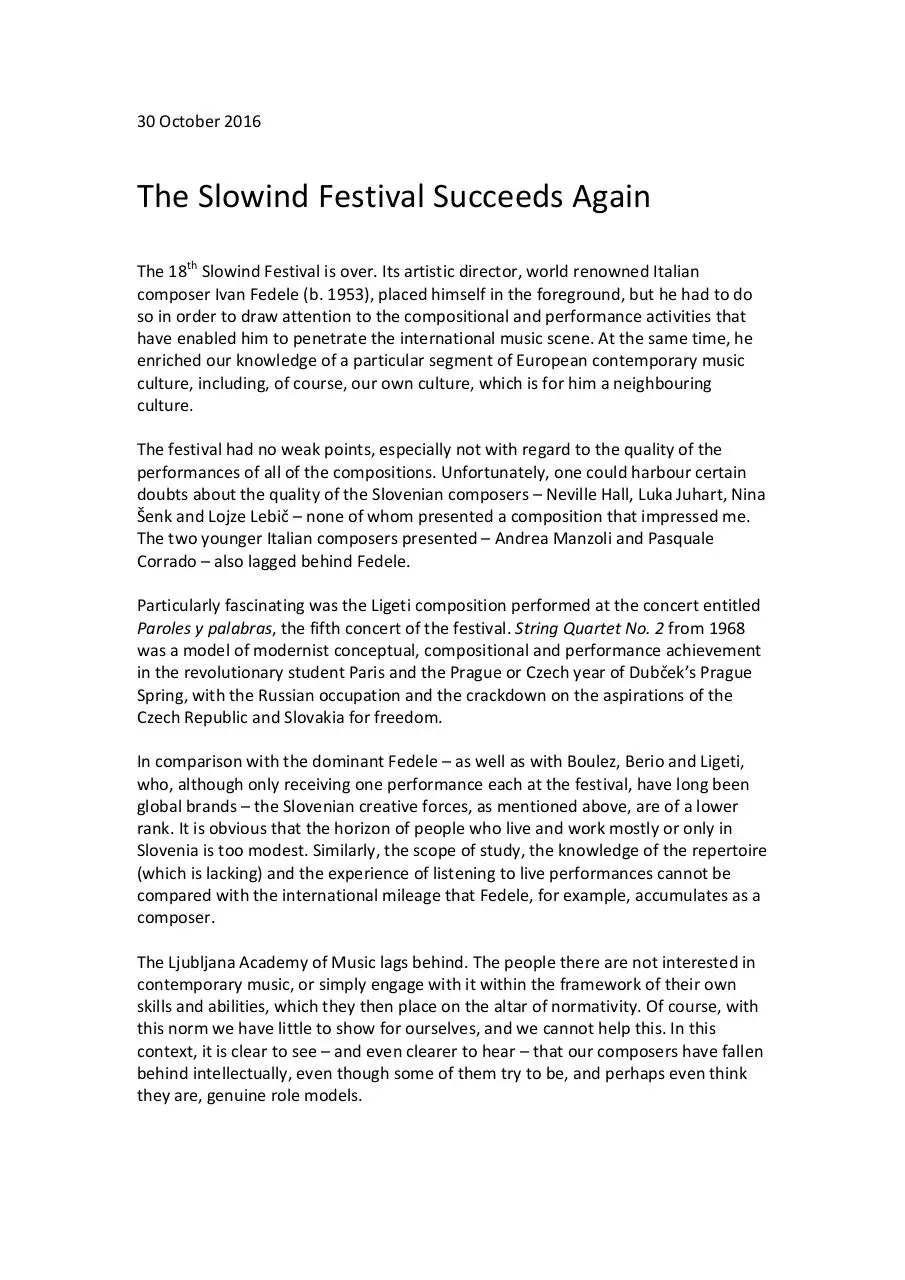Slowind Review Zlobec Nov 2016 (PDF)
File information
Title: Slowind Review Zlobec Nov 2016
Author: Ivan
This PDF 1.3 document has been generated by Word / Mac OS X 10.12.1 Quartz PDFContext, and has been sent on pdf-archive.com on 02/12/2016 at 13:00, from IP address 37.117.x.x.
The current document download page has been viewed 555 times.
File size: 90.88 KB (4 pages).
Privacy: public file




File preview
30 October 2016
The Slowind Festival Succeeds Again
The 18th Slowind Festival is over. Its artistic director, world renowned Italian
composer Ivan Fedele (b. 1953), placed himself in the foreground, but he had to do
so in order to draw attention to the compositional and performance activities that
have enabled him to penetrate the international music scene. At the same time, he
enriched our knowledge of a particular segment of European contemporary music
culture, including, of course, our own culture, which is for him a neighbouring
culture.
The festival had no weak points, especially not with regard to the quality of the
performances of all of the compositions. Unfortunately, one could harbour certain
doubts about the quality of the Slovenian composers – Neville Hall, Luka Juhart, Nina
Šenk and Lojze Lebič – none of whom presented a composition that impressed me.
The two younger Italian composers presented – Andrea Manzoli and Pasquale
Corrado – also lagged behind Fedele.
Particularly fascinating was the Ligeti composition performed at the concert entitled
Paroles y palabras, the fifth concert of the festival. String Quartet No. 2 from 1968
was a model of modernist conceptual, compositional and performance achievement
in the revolutionary student Paris and the Prague or Czech year of Dubček’s Prague
Spring, with the Russian occupation and the crackdown on the aspirations of the
Czech Republic and Slovakia for freedom.
In comparison with the dominant Fedele – as well as with Boulez, Berio and Ligeti,
who, although only receiving one performance each at the festival, have long been
global brands – the Slovenian creative forces, as mentioned above, are of a lower
rank. It is obvious that the horizon of people who live and work mostly or only in
Slovenia is too modest. Similarly, the scope of study, the knowledge of the repertoire
(which is lacking) and the experience of listening to live performances cannot be
compared with the international mileage that Fedele, for example, accumulates as a
composer.
The Ljubljana Academy of Music lags behind. The people there are not interested in
contemporary music, or simply engage with it within the framework of their own
skills and abilities, which they then place on the altar of normativity. Of course, with
this norm we have little to show for ourselves, and we cannot help this. In this
context, it is clear to see – and even clearer to hear – that our composers have fallen
behind intellectually, even though some of them try to be, and perhaps even think
they are, genuine role models.
In Fedele, one can observe growth in terms of structure, intellect, cognition,
invention, imagination, potency, performance, etc. The rendering in dialogue and
problematisation of the creative process, the realisation of ideas, the transition from
musical notation to a quality performance, the control of the whole process,
listening to and hearing what is hidden in the notes that are written or copied out in
full ... in the case of Fedele, these are a constant.
At a press conference some twenty years ago in Ljubljana’s Cankarjev Dom, the
celebrated Polish composer Krzysztof Penderecki said that on a few occasions he had
left the interpretation of his compositions to the performers, but that he regretted
having done so. In fact, the composer must notate everything, and the interpreter
must subsequently perform everything exactly as written.
Ivan Fedele knows this. Thus, his compositions can be performed by everyone with
the appropriate training. As we witnessed, however, Fedele himself ensured that his
works, of which perhaps as many as fifteen were presented in Ljubljana, were
performed mostly by his invited Italian guests, who have a long history of
collaboration with the composer and who are aware of his musical abilities. Similarly,
it was at the Venice Biennale of Contemporary Music that Fedele met Slowind; in
fact, prior to the Biennale, as it was he who invited the quintet to the festival.
The wind quintet Slowind has already realised so many projects that there is no need
to harbour concerns for the future of the Slowind Festival, especially if the ensemble
continues to succeed in establishing contact with the contemporary compositional
world. In this world, there is a whole range of young people to whom many festivals
of contemporary music are opening their doors, such as the festival Wien Modern,
which got underway a few days ago and will be present as many as 88 musical
events.
At the Slowind Festival, there was a noticeable absence of the Italian Cultural
Institute in Slovenia and the Embassy of the Republic of Italy, even though the
festival represented an affirmation of Italian musical culture, with some ten
internationally renowned Italian guests. If Italians are not interested, why should
others bother about them? It is clear that that they made no contribution
whatsoever to the festival.
In the middle of the festival, Ivan Fedele had to hurry home to his sick mother, but
he soon returned to Ljubljana. At the end of the festival, he was very pleased.
Although it seemed that Ljubljana had been his largest individual festival to date, he
in fact commented at the conclusion of events that there had been similar festivals
with his strong participation before, in Paris, London, Frankfurt, Strasbourg, etc. In
Ljubljana, however, Fedele was impressed with the relaxed atmosphere and the
discussions, both with students and with the audience of the concerts and
colleagues at the post-concert social gatherings.
The very poor attendance at the first concerts was particularly noticeable, which
again is a reflection of the climate in our leading or top-level institutions; music
students, who actually study music, are interested neither in the compositional,
creative side, nor in the instrumental, performance side, while their teachers, who
lecture on music, are even less interested. It is grotesque to observe the fear that
reigns among people when they hear something that goes far beyond their artistic
range. It is, however, precisely these people who are in power at home, and who
decide about virtually everything. Tomorrow they will behave as if the Slowind
Festival, for example, did not exist and that we heard “nothing”.
This could be understood as their own personal “problem”, but another aspect arises
when you note that it is precisely these people who decide, evaluate, organise,
disable, etc. I have heard from students who are studying at universities or
academies in Austria how differently they teach music history in Salzburg, Graz and
Vienna compared with Ljubljana, and what the study conditions are like for pianists,
for example, in Germany, The Netherlands, England, USA, France, Switzerland,
Canada, Australia, etc.
Ivan Fedele was also successfully incorporated into the subscription series of the
Slovenian Philharmonic, with his Violin Concerto being performed at two evening
concerts. The composition was created during the composer’s first collaboration
with the Parisian Ensemble InterContemporain and the institute for musical and
acoustic research IRCAM. The concerto was premiered by a violinist from the
ensemble, but subsequent performances have mainly been given by the soloist who
performed in Ljubljana, violinist Francesco D’Orazio.
The soloist performs the concerto with two violins: the first part with a normal violin,
and the second with a five-string electric violin. Thus, Fedele creates a dialogue in
time and content, a link between the Berg-like atmosphere of the Viennese avantgarde and the birth and global expansion of jazz and then rock music. Although the
concerto does not, of course, allude specifically to rock music, but more to jazz, in
the last minutes, with the stronger use of the pedal, thereby achieving a different,
more voluminous sound, it almost approaches the legendary Jimi Hendrix, a personal
favourite of Fedele.
In his festival, Ivan Fedele also included two of his composition students, Andrea
Manzoli (b. 1977) and Pasquale Corrado (b. 1979). I have already mentioned
Manzoni and his Crosswinds for wind quintet, written this year, in another review.
Pasquale Corrado contributed Pulse for flute, clarinet, piano, percussion, violin and
cello, with the ensemble being conducted by the composer. Pulse can be molecular
(the composer says that one single molecule causes a succession of irrationality), but
there is nonetheless more to listen to on an internal, emotional level, until the
otherwise rather illogical end.
At the fifth concert, Ivan Fedele had three performances of his own works: Parole y
palabras (2006), comprising four pieces for soprano and cello; Palimpsest
(2006/2007), which is his fourth string quartet; and Morolòja Kè Erotikà (2010/2011)
for soprano and string quartet. The best was the latter, performed by Quartetto
Prometeo and soprano Valentina Coladonato. In this work, the composer uses five
poems from the collection Canti di pianto e d’amore dall’antico Salento, written in
the Griko dialect, which is a mixture of Hellenic Greek and the Pula dialect. Soprano
Valentina Coladonato was excellent in both of her appearances. Although she has
performed extensively in opera, even working with Riccardo Muti, she says that she
now prefers to engage primarily with contemporary and chamber music.
Ivan Fedele’s Mudrā (2013), performed at the eighth concert, concluded the festival.
It was preceded by two other Fedele compositions: Immagini da Escher (2005) for
flute, clarinet, piano, percussion, violin and cello; and Mosaïque (2008) for violin and
seventeen performers. Dutch artist Maurits Cornelis Escher (1898–1972) was a
celebrated painter, drawer, illustrator, watercolourist and printmaker.
In his composition, Fedele probably mainly had in mind Escher’s “impossible
constructions”, which involve a variety of transformations. The composer was
apparently provoked by the painter’s “mathematically – geometrically – figurative
principles” and the “paradoxical realisation of multidimensional images”. There are
seven such images, and one could say that it is a case of their contemporary sonic
visualisation, as indicated by the titles of some of their movements, such as Peaceful
with Ruptures, Rainbow, Cadencing, Volcanic, etc. In Mosaïque for violin and
seventeen players, violinist Francesco D’Orazio again demonstrated his skill. The
composition is reminiscent of a work for solo violin performed at the beginning of
the festival, Viaggiatori della notte (1983), which gave rise to the title of the
festival’s second concert, Night Travellers.
Fedele is a master of expansion, even though the creative concept and aesthetics in
his oeuvre have changed over time. Mudrā is more “problematic” because it is based
on the different meanings of the work’s title in Sanskrit: mark, sign, symbol, symbolic
gesture. Fedele speaks of three sonic sculptures, and more of anamorphosis
(essentially optical illusion) than metamorphosis. I would add that these sculptures
are white or even transparent, high and perhaps even kinetic. I see them when I
listen to the music of Ivan Fedele.
Marijan Zlobec
Download Slowind Review Zlobec Nov 2016
Slowind Review Zlobec Nov 2016.pdf (PDF, 90.88 KB)
Download PDF
Share this file on social networks
Link to this page
Permanent link
Use the permanent link to the download page to share your document on Facebook, Twitter, LinkedIn, or directly with a contact by e-Mail, Messenger, Whatsapp, Line..
Short link
Use the short link to share your document on Twitter or by text message (SMS)
HTML Code
Copy the following HTML code to share your document on a Website or Blog
QR Code to this page

This file has been shared publicly by a user of PDF Archive.
Document ID: 0000516264.